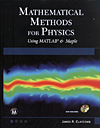- About MAA
- Membership
- MAA Publications
- Periodicals
- Blogs
- MAA Book Series
- MAA Press (an imprint of the AMS)
- MAA Notes
- MAA Reviews
- Mathematical Communication
- Information for Libraries
- Author Resources
- Advertise with MAA
- Meetings
- Competitions
- Programs
- Communities
- MAA Sections
- SIGMAA
- MAA Connect
- Students
- MAA Awards
- Awards Booklets
- Writing Awards
- Teaching Awards
- Service Awards
- Research Awards
- Lecture Awards
- Putnam Competition Individual and Team Winners
- D. E. Shaw Group AMC 8 Awards & Certificates
- Maryam Mirzakhani AMC 10 A Awards & Certificates
- Two Sigma AMC 10 B Awards & Certificates
- Jane Street AMC 12 A Awards & Certificates
- Akamai AMC 12 B Awards & Certificates
- High School Teachers
- News
You are here
Mathematical Methods for Physics Using MATLAB and Maple

Publisher:
Mercury Learning
Publication Date:
2018
Number of Pages:
820
Format:
Hardcover with CDROM
Price:
89.95
ISBN:
9781683920984
Category:
Textbook
[Reviewed by , on ]
Eric Stachura
10/12/2018
This book has two parts. The first part, including Chapters 1–9, is mainly a review of mathematical techniques useful to solve various applied math or physics problems. The beginning topics are quite basic (algebra and trigonometry) and range all the way up to partial differential equations and complex analysis. Since such a plethora of topics are covered, no individual subject is covered in very much detail. Examples in Maple are provided at the end of each section, and MATLAB examples are given at the end of each chapter. Each section ends with a good number of exercises, which the author states “should be solved using Maple, MATLAB, by hand, or by using a combination of approaches.’ This is a nice layer of flexibility for the instructor.
The second part of the book, Chapters 10–16, focuses on purely physical concepts, ranging from classical mechanics to relativistic quantum mechanics. The style of this part of the book is the same as the first part, with Maple examples at the end of each section and MATLAB examples at the end of each chapter. Illustrations given within each section aid the reader in visualizing the example problems.
This book is definitely not meant to serve as a main course textbook, but rather as a secondary reference. The explicit code in Maple and MATLAB that is provided is quite helpful for the student learning from this book, especially if they are new to these languages. The target audience is undergraduate and/or beginning graduate students taking courses in theoretical physics or mathematical methods in physics. I would perhaps say the book is more geared towards the former, for courses offered in a physics department. That being said, there is sufficient flexibility in the book, especially since it should be used as a secondary resource, that it can be adapted to the needs of each instructor.
The book is quite large (approximately 800 pages), so it might best be used for specific topics. References are given for each section, but they could be more thorough. Overall this would serve as a nice student companion resource, especially for those students new to programming.
Eric Stachura is currently an Assistant Professor of Mathematics at Kennesaw State University. He is generally interested in analysis and partial differential equations, especially treated with functional analysis techniques.
1. Fundamentals
2. Vectors Matrix Methods
3. Calculus
4. Vector Calculus
5. Ordinary Differential Equations
6. Special Functions
7. Fourier Series and Integral Transforms
8. Partial Differential Equations
9. Complex Analysis
10. Classical Mechanics
11. Electromagnetics
12. Quantum Mechanics
13. Statistical Mechanics
14. Special Relativity
15. General Relativity
16. Relativistic Quantum Mechanics
Bibliography
Appendices
Index
- Log in to post comments




